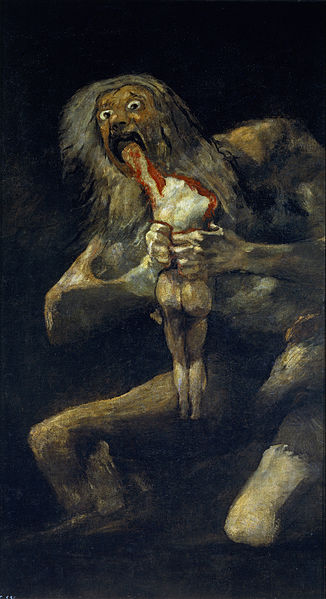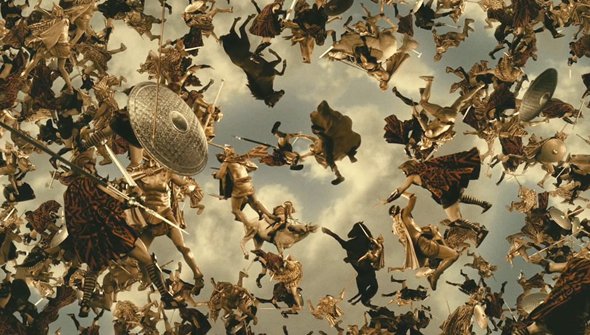T. H. M. Gellar-Goad
December 15, 2013
Why has the Titanomachy been so fascinating a subject for movies, TV, and video games in recent years?
 In Greek myth, the Titans were the gods who ruled the cosmos in the generation before the ascent of the Olympians (Zeus, Hera, Poseidon, Hades, and the like). The king of the Titans, Kronos, came to power by castrating his father Ouranos and held onto that power — in view of a prophecy that his son would overthrow him — by swallowing each of his children at birth. But his wife, Rhea, replaced baby Zeus with a rock and hid him on the island of Crete until he grew strong enough to force Kronos to regurgitate his siblings, whom he then led in battle against Kronos and kin. This battle, the war of the Olympians against the Titans, is called the Titanomachy, and can be considered the first war of Greek myth. It takes up a full fifth of (what survives of) Hesiod’s Theogony, a poem about the birth of the gods (old-timey translation here), with a vivid description of the effects of Zeus’ prodigious use of the thunderbolt:
In Greek myth, the Titans were the gods who ruled the cosmos in the generation before the ascent of the Olympians (Zeus, Hera, Poseidon, Hades, and the like). The king of the Titans, Kronos, came to power by castrating his father Ouranos and held onto that power — in view of a prophecy that his son would overthrow him — by swallowing each of his children at birth. But his wife, Rhea, replaced baby Zeus with a rock and hid him on the island of Crete until he grew strong enough to force Kronos to regurgitate his siblings, whom he then led in battle against Kronos and kin. This battle, the war of the Olympians against the Titans, is called the Titanomachy, and can be considered the first war of Greek myth. It takes up a full fifth of (what survives of) Hesiod’s Theogony, a poem about the birth of the gods (old-timey translation here), with a vivid description of the effects of Zeus’ prodigious use of the thunderbolt:
The land boiled, and every stream of Ocean, and the uncultivated sea. The hot blast surrounded the earthborn Titans, unspeakable fire approached the bright sky, and the gleaming bright light of the thunderbolt and lightning blinded their eyes, though they were strong. [Theogony lines 695–699, translation mine]
The Titanomachy ends with a victory for Zeus and the Olympians, thanks to the strongarm help of the hundred-handed monster-children of Mother Earth, who imprison the Titans in Tartarus, the deepest part of the underworld.
So much for the myth. There are a number of treatments of the Titans in modern popular media. And in almost every single one, the story is not the Titanomachy itself, but rather the reawakening or escape of the Titans from their prison, and the commencement or threat of a second war between Titans and Olympians. It seems to me that this basic storyline, and the set of other plot elements that seem intrinsically associated with it, touch on a number of social/political anxieties in America today, as I’ll talk about in next month's column. [Mega spoilers starting in the next paragraph!]
The film that made “Titan” a household name, the 1981 Clash of the Titans, only engages superficially with the Titans: the monsters Medusa and the Kraken are called “the last of the Titans,” both destined to be defeated in separate clashes with the movie’s hero Perseus. But Wrath of the Titans—the 2012 sequel to the 2010 remake of Clash of the Titans — centers on a plot by Hades and Ares to release the Titans in order to overthrow Zeus. The hero, Perseus, is called out of retirement to help his father Zeus (and eventually Hades, who is betrayed by Ares and then reconciled with Zeus) defeat a reawakened Kronos. They succeed — but Zeus dies in the battle.
 Wrath of the Titans is uncannily similar in plot to the 1997 Disney Hercules, where the titular hero must block Hades’ attempt to unleash the Titans and claim Zeus’ power for his own. (The recurring, Christianizing depiction of Hades as devilish villain owes a lot to this film, as described in a 2012 CAMWS presentation by Martha Payne; here’s the abstract in .doc format.) Another animated film from the mid 1990s, the direct-to-video Hercules and Xena, the Animated Movie: The Battle for Mount Olympus, has Kevin Sorbo’s Hercules reluctantly defending the Olympian gods against an assault by the Titans, who are in the end reimprisoned by Hercules, with the help of Xena and their respective sidekicks. Whereas Disney’s Hercules reshapes traditional Greek myth by making Hera a loving, long-lost mother to Hercules, the Hercules and Xena movie — as in the much-loved Hercules and Xena TV series — makes her into an evil villain who is responsible for freeing the Titans and leading them against the Olympians.
Wrath of the Titans is uncannily similar in plot to the 1997 Disney Hercules, where the titular hero must block Hades’ attempt to unleash the Titans and claim Zeus’ power for his own. (The recurring, Christianizing depiction of Hades as devilish villain owes a lot to this film, as described in a 2012 CAMWS presentation by Martha Payne; here’s the abstract in .doc format.) Another animated film from the mid 1990s, the direct-to-video Hercules and Xena, the Animated Movie: The Battle for Mount Olympus, has Kevin Sorbo’s Hercules reluctantly defending the Olympian gods against an assault by the Titans, who are in the end reimprisoned by Hercules, with the help of Xena and their respective sidekicks. Whereas Disney’s Hercules reshapes traditional Greek myth by making Hera a loving, long-lost mother to Hercules, the Hercules and Xena movie — as in the much-loved Hercules and Xena TV series — makes her into an evil villain who is responsible for freeing the Titans and leading them against the Olympians.
 More recently, in Percy Jackson: Sea of Monsters, the 2013 adaptation of the novel of the same name, the Perseus-like half-god protagonist finds himself fighting to prevent Kronos from being unleashed upon the world by another power-hungry demigod, this time the son of Hermes who (along with diabolical Hades once again) was the main villain of the first Percy Jackson movie. The whole Percy Jackson & the Olympians young-adult fiction series culminates with a battle against Kronos and a new Titanomachy, with many more twists and turns than the movies, at least as my niece tells it; see a review by Jim & Marika O’Hara in the APA’s Amphora magazine here in PDF. The setting of the 2005–2008 cartoon Class of the Titans is essentially the same. And Immortals, from 2011, shows the human king “Hyperion” releasing the Titans to punish the Olympians for not saving his family from a tragic death; the movie’s hero, Theseus, must defeat Hyperion while Zeus deals with the Titans (Athena and Apollo are both killed in the fight).
More recently, in Percy Jackson: Sea of Monsters, the 2013 adaptation of the novel of the same name, the Perseus-like half-god protagonist finds himself fighting to prevent Kronos from being unleashed upon the world by another power-hungry demigod, this time the son of Hermes who (along with diabolical Hades once again) was the main villain of the first Percy Jackson movie. The whole Percy Jackson & the Olympians young-adult fiction series culminates with a battle against Kronos and a new Titanomachy, with many more twists and turns than the movies, at least as my niece tells it; see a review by Jim & Marika O’Hara in the APA’s Amphora magazine here in PDF. The setting of the 2005–2008 cartoon Class of the Titans is essentially the same. And Immortals, from 2011, shows the human king “Hyperion” releasing the Titans to punish the Olympians for not saving his family from a tragic death; the movie’s hero, Theseus, must defeat Hyperion while Zeus deals with the Titans (Athena and Apollo are both killed in the fight).
The popular video game series God of War centers on a Spartan soldier named Kratos (a son of Zeus, as it eventually turns out) who, after slaughtering his wife and children in a battle-rage, gets revenge by killing Ares and taking his place on Olympus. In God of War II, Kratos is betrayed by Zeus, killed, saved from the Underworld by Gaia, and convinced by her to free the Titans against Olympus. God of War III begins with the assault on Olympus, which features fights against a number of Olympians, whose deaths bring about natural disasters: Poseidon’s death brings global ocean flooding, Hades’ results in all the souls of the dead escaping to cause chaos on earth, Helios’ plunges the earth into stormy darkness, Hermes’ unleashes a worldwide plague, Hera’s extinguishes all plant life. (Hercules, whose death isn’t linked with such a calamity, is voiced by none other than Kevin Sorbo.) In the end, Kratos is betrayed by Gaia, kills her, kills Zeus, and is not-quite-fatally stabbed by Athena.
In my next installment, I trace the pattern running through these Titanomachies and discuss its social implications.

